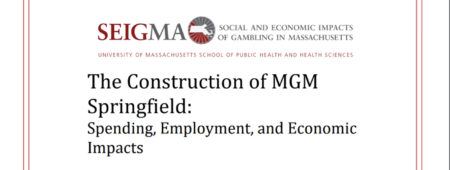UMass Amherst researchers release findings on the economic impacts of MGM Springfield construction
- September 26, 2019
- by MGC Communications
- 0 comments

Researchers from the UMass Donahue Institute, as part of the Social and Economic Impacts of Gambling in Massachusetts (SEIGMA) research study at UMass Amherst, have released findings on the economic impacts of constructing MGM Springfield. Specifically, these findings detail: 1) where the construction dollars were spent (regionally and statewide), 2) where the construction workers resided and whether it was a diverse workforce, and 3) what were the total statewide economic impacts of constructing MGM Springfield. The findings were released today after the Massachusetts Gaming Commission open meeting in Springfield.
Rod Motamedi, senior research manager at the UMass Donahue Institute and lead author of the report, comments on the importance of this research:
“A construction project of this scale tends to result in most attention focusing on the construction site itself. Our goal is to show how activity that seems contained to one place actually spreads throughout the Commonwealth and impacts businesses, workers, and communities not only where the construction is happening but in other regions. Overall, we found that every county in the Commonwealth saw some economic benefit from the construction of MGM Springfield. The economic benefits did ultimately tend to grow with proximity to Springfield.”
MGM Resorts International spent $573.3 million to build the MGM Springfield casino. This amount differs from the larger amount that is commonly reported in the press. The larger amount represents total investment of which construction is a component.
Where were the construction dollars spent?
- Two-thirds of the construction budget ($373.8M of $573.2M) went to firms based in Massachusetts. Half of that ($194.3M) (or a third of the total) remained in Hampden County.
- Nearly $84M went to firms based in the City of Springfield.
- Of the remaining third that went out of state ($199.5M), about half went to firms in nearby Connecticut with the remainder spread across 16 other states and Canada.
- About one-third of the total contract value went to firms that met at least one element of the diversity criteria (i.e., Woman-, Minority-, or Veteran-Owned Business).
Where did construction workers reside and was it a diverse workforce?
- Over two-thirds (2,963 of 4,249) of the construction workers were Massachusetts residents. Most of the remainder were from Connecticut.
- In total, the most common place of residence was Hampden County, where 36 percent (1,524 of 4,249) of the workers resided. Of this 36 percent, 509 were Springfield residents.
- Workforce diversity statistics suggest that the MGM Springfield construction workforce largely reflects the composition of the populations from which they are drawn.
- One-quarter of Massachusetts-resident construction workers employed during the construction of MGM Springfield were minorities, which is similar to the minority share of the statewide population. Overall, the construction workers were over 90 percent male and non-veteran.
- In Springfield, the population is majority minority. Overall, the shares of White and minority MGM Springfield construction workers who were from Springfield are similar to their shares of the city’s population. Within the minority workers, Black MGM Springfield construction workers from Springfield were overrepresented and Hispanic MGM Springfield construction workers from Springfield were underrepresented compared to their shares of the Springfield population.
What were the total statewide economic impacts of constructing MGM Springfield?
- Increases in company revenues and employment drive larger changes in the economy.
- Overall, total statewide economic activity (also known as output) increased by $849 million over the five-year construction period.
- Net new economic activity (i.e., value added or gross state product) totaled $512 million.
- About 1,000 jobs were created or supported by this economic activity. These jobs accrued $397 million of income.
- Every $2 of construction spending created $1 of additional activity in Massachusetts. Every $1 of compensation to construction workers created an additional $1.29 of income to others in Massachusetts.
The SEIGMA research team looks forward to releasing a report on the economic impacts of constructing Encore Boston Harbor in the summer of 2020.
About MassGaming
The mission of the Massachusetts Gaming Commission is to create a fair, transparent, and participatory process for implementing the expanded gaming law passed by the Legislature and signed by the Governor in November 2011. In creating that process, the Commission will strive to ensure that its decision-making and regulatory systems engender the confidence of the public and participants, and that they provide the greatest possible economic development benefits and revenues to the people of the Commonwealth, reduce to the maximum extent possible the potentially negative or unintended consequences of the new legislation, and allow an appropriate return on investment for gaming providers that assures the operation of casino-resorts of the highest quality. For more information on MGC, please visit MassGaming.com or connect and share on Twitter (@MassGamingComm) or Facebook www.facebook.com/MAGamingComm.
About the Social and Economic Impacts of Gambling in Massachusetts (SEIGMA) research study
The University of Massachusetts Amherst School of Public Health & Health Sciences (SPHHS) has been engaged by the Massachusetts Gaming Commission (MGC) to carry out a comprehensive, multi-year research project, believed to be the first of its kind, on the economic and social impacts of introducing casino gambling in Massachusetts. The project fulfills Section 71 of the 2011 Expanded Gaming Act, which requires the MGC to establish “an annual research agenda” to assist in understanding the social and economic effects of the introduction of casino gambling in MA, and in making annual scientifically-based recommendations to the Legislature. For more information on the SEIGMA research study, please visit http://www.umass.edu/seigma or connect on Twitter (@ImpactsMA).
About the University of Massachusetts Donahue Institute
The University of Massachusetts Donahue Institute is an outreach and economic development arm of the University of Massachusetts President’s Office. Established in 1971, the Institute strives to connect its clients with the resources of the University, bridging theory and innovation with real world public and private sector applications. For more information: www.donahue.umassp.edu or visit @UMASSDonahue on Twitter.